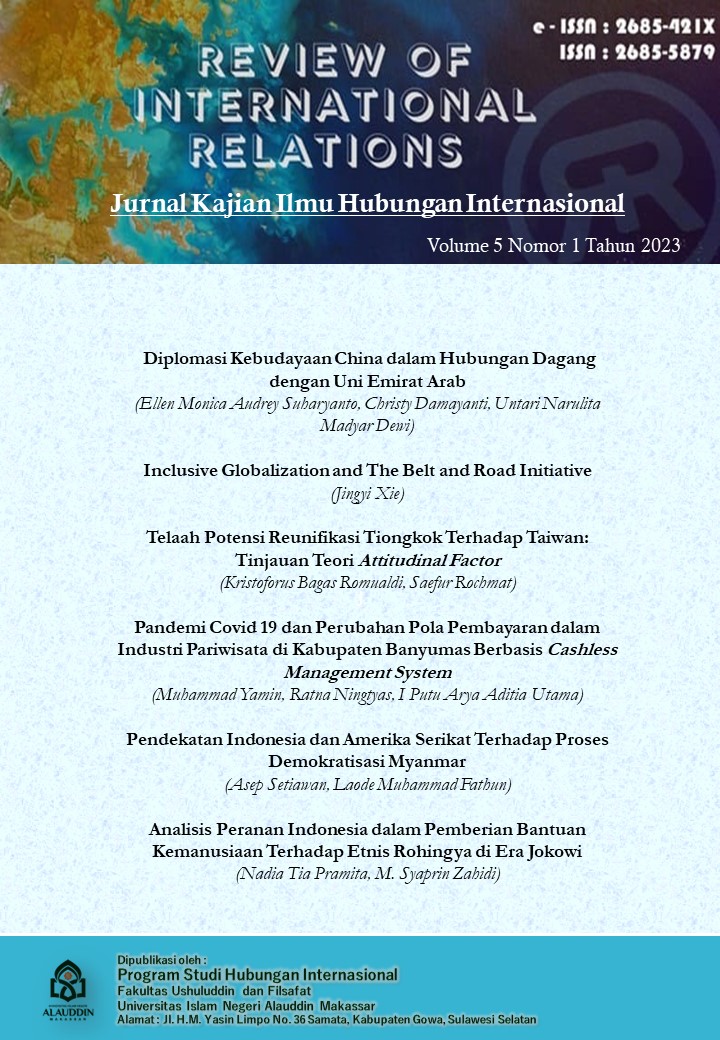Pendekatan Indonesia dan Amerika Serikat Terhadap Proses Demokratisasi Myanmar
Abstract
The paper asseses Indonesian and US approach toward Myanmar democratisation as consequences of globalisation of democracy. The US put pressure and political and economic boycott toward Myanmar to push democratisation process. In other hand, Indonesia insist that democratisation in Myanmar part of its domestic affair and no need foreign intervention. This approach is in line with basic principles of ASEAN including to build constructive engagement with Myanmar. Indonesian approach seems more suitable to create changes toward demoratisation in the Myanmar.
Downloads
References
Chun, Kwangho. 2008. “External Intervention and Democratisation in Myanmar:
A Policy Evaluation.” King’s College London.
Haryono, Endi. 1997. “ASEAN Menanggapi Sanksi Ekonomi AS terhadap
Myanmar 1997.” Paradigma. Vol. 1. No. 2.
Hlaing, Kyaw Yin. 2008. ASEAN’s Pariah: Insecurity and Autocracy in Myanmar
(Burma), in: D. Emmerson (ed.), Hard Choices: Security, Democracy and Regionalism in Southeast Asia, Stanford, CA: Walter H. Shorenstein Asia-Pacific Research Center Books, 151–190.
Huang, Roger Lee. 2016. Myanmar’s Way to Democracy and the Limits of the
Elections. Asian Journal of Political Science.
Jagan L. 2012. Late Burma Spring Signals Tentative Change, in: Asian
Conversations, 1 January, online:
Kurlantzick, J. 2012. Why Burma’s Free Election Wasn’t All It Was Cracked
Up To Be, in: New Republic, 3 April, online:
lic.com/article/world/102279/burma-elections-aung-san-kyi#> .
Lee, Lavina. 2014. “Myanmar’s Transition to Democracy: New Opportunities or
Obstacles for India?” Contemporary Southeast Asia Vol. 36, No. 2, pp. 290-316.
Lidauer, Michael. “Democratic Dawn? Civil Society and Elections in Myanmar
–2012.” Journal of Current Southeast Asian Affairs 2012: 87–114.
Pradahan, Sanjay Kumar. 2008. “Struggle for Democracy in Myanmar : Response
of Neighbours, United States and ASEAN.” Jadavpur Journal of International Relations.
Presidential Documents. Blocking Property and Prohibiting Certain Transactions
Related to Burma, Executive Order 13448 of October 18, 2007.
Renshaw, Catherine Shanahan. 2013. “Democratic Transformation and Regional
Instituions: The Case of Myanmar and ASEAN”. Journal of Current Southeast Asian Affairs 1/2013:29-54.
Sidauruk, Wilson Rojeki.2015. Peran The Institute for Peace and Democracy
(IPD) Dalam Demokratisasi di Myanmar. Pekanbaru: Universitas Riau.
Siemers, Gunter. 1993. Myanmar 1992: Heading For "Guided Democracy"?
Southeast Asian Affairs. pp. 245-266.
Than. Tin Maung Maung. 2000. “Myanmar: The Dilemma of Stalled Reforms.”
Fellow ISEAS. No. 10. hal. 2.
Thawnghmung, Ardeth. 2016. “The Myanmar Elections 2015: Why the National
League for Democracy Won a Landslide Victory.” Critical Asian Studies. 48:1, 132-142.
https://en.wikipedia.org/wiki/Myanmar
https://en.wikipedia.org/wiki/Roadmap_to_democracy
Van der Loos, Kenny. 2014. Indonesia’s Policy Towards an ASEAN Pariah
Striking a Balance between Democratic Values and Constructive Engagement. Thesis di Universiteit Leiden.
Zaw Aung. 2016. “Emerging Democracy and Ethnic Identity Crisis in Myanmar.”
Dalam Chantana Banpasirichote Wungaeo, Boike Rehbein Surichai Wun'gaeo (eds). Globalization and Democracy in Southeast Asia: Challenges, Responses and Alternative Futures.London: Palgrave Macmillan.
Copyright (c) 2023 muhamad Fathun

This work is licensed under a Creative Commons Attribution-ShareAlike 4.0 International License.










